University of Wollongong: Instructional Leadership Report - EDGL911
VerifiedAdded on 2022/09/16
|10
|1982
|24
Report
AI Summary
This report delves into the multifaceted realm of instructional leadership within educational institutions. It begins by defining instructional leadership and highlighting its critical importance in managing curriculum, monitoring performance, and allocating resources to foster student growth. The report then analyzes the challenges faced by instructional leaders, such as maintaining transparency, addressing time constraints, and overcoming resistance to change, while also offering potential solutions to these issues. The second section reflects on the practical application of instructional leadership principles, outlining specific strategies for communication, task structuring, and follow-up practices, providing insights into the role of an aspiring educational leader. It emphasizes the significance of effective communication, the establishment of routines, and the structured approach to task management, all aimed at enhancing instructional leadership styles and promoting a positive learning environment. The paper concludes by summarizing the key findings and offering a call to action for aspiring educational leaders.
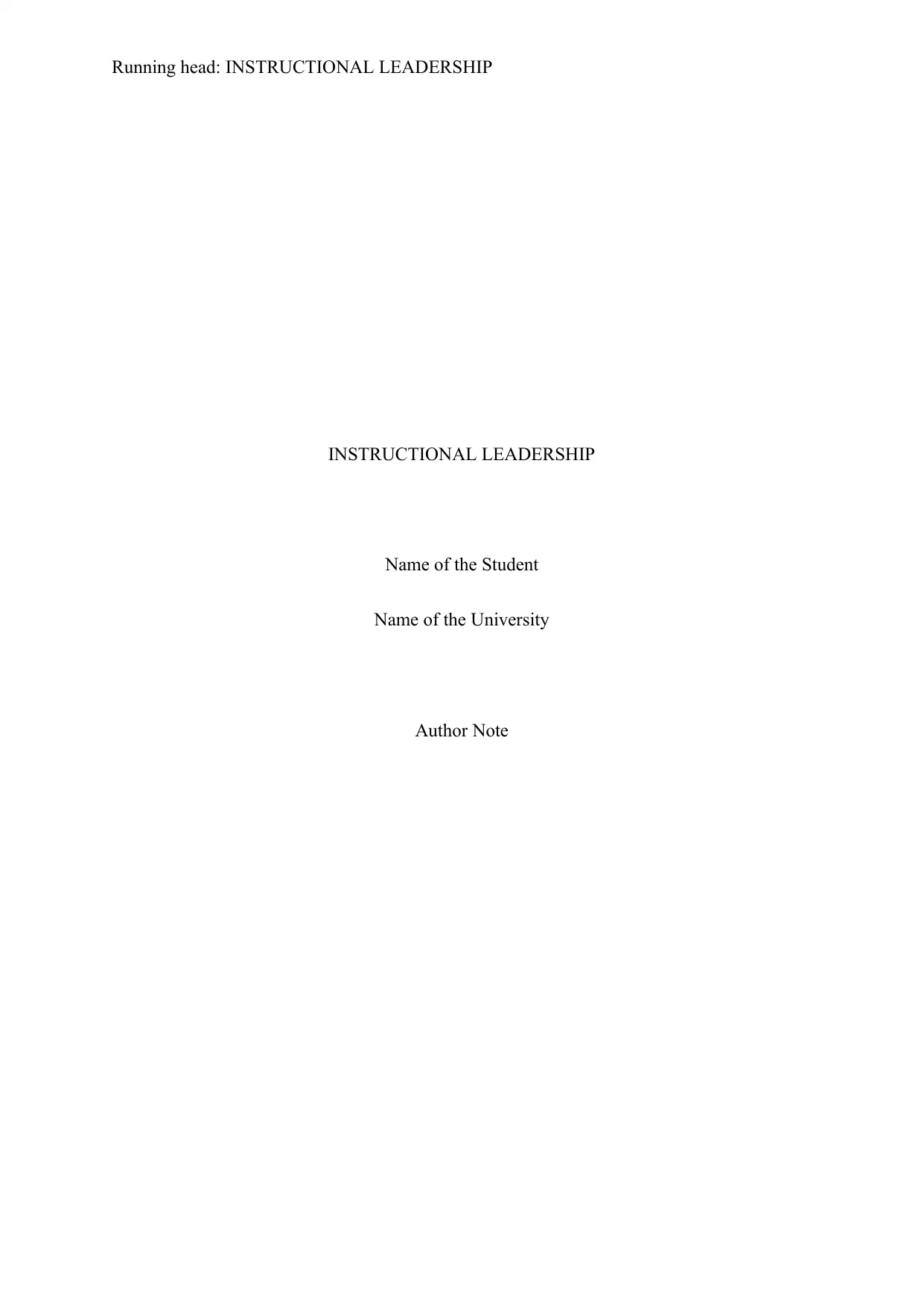
Running head: INSTRUCTIONAL LEADERSHIP
INSTRUCTIONAL LEADERSHIP
Name of the Student
Name of the University
Author Note
INSTRUCTIONAL LEADERSHIP
Name of the Student
Name of the University
Author Note
Paraphrase This Document
Need a fresh take? Get an instant paraphrase of this document with our AI Paraphraser
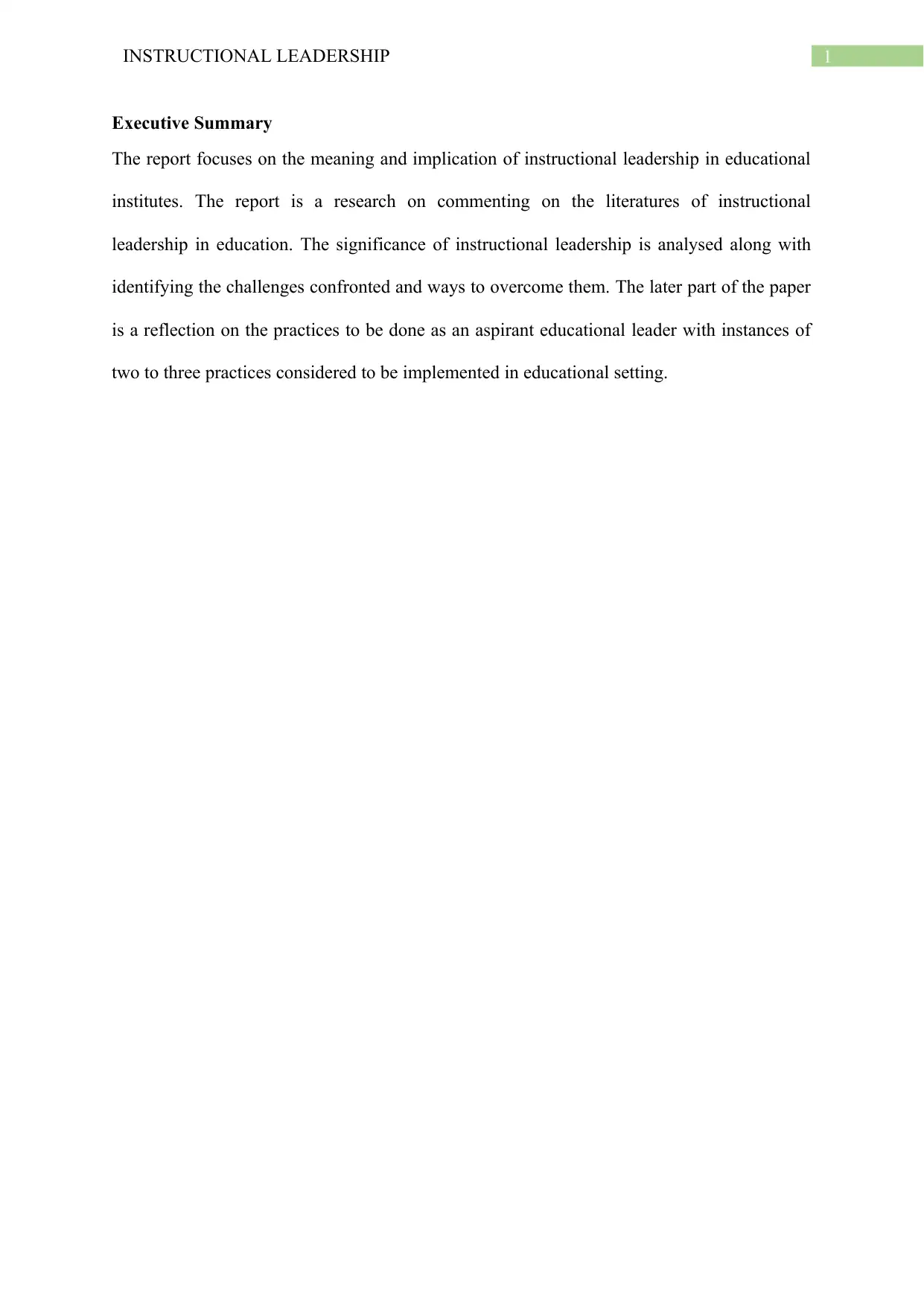
1INSTRUCTIONAL LEADERSHIP
Executive Summary
The report focuses on the meaning and implication of instructional leadership in educational
institutes. The report is a research on commenting on the literatures of instructional
leadership in education. The significance of instructional leadership is analysed along with
identifying the challenges confronted and ways to overcome them. The later part of the paper
is a reflection on the practices to be done as an aspirant educational leader with instances of
two to three practices considered to be implemented in educational setting.
Executive Summary
The report focuses on the meaning and implication of instructional leadership in educational
institutes. The report is a research on commenting on the literatures of instructional
leadership in education. The significance of instructional leadership is analysed along with
identifying the challenges confronted and ways to overcome them. The later part of the paper
is a reflection on the practices to be done as an aspirant educational leader with instances of
two to three practices considered to be implemented in educational setting.
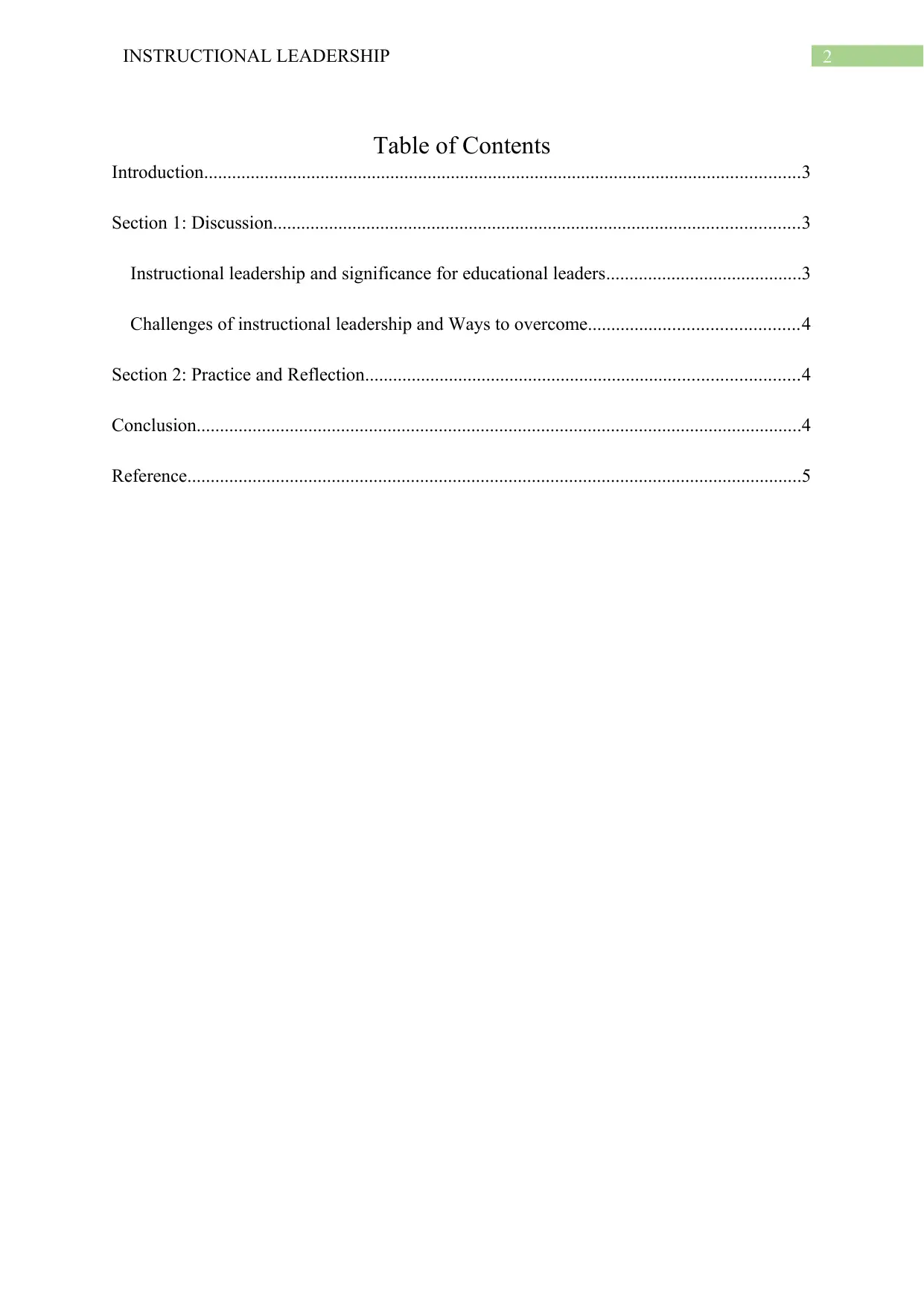
2INSTRUCTIONAL LEADERSHIP
Table of Contents
Introduction................................................................................................................................3
Section 1: Discussion.................................................................................................................3
Instructional leadership and significance for educational leaders..........................................3
Challenges of instructional leadership and Ways to overcome.............................................4
Section 2: Practice and Reflection.............................................................................................4
Conclusion..................................................................................................................................4
Reference....................................................................................................................................5
Table of Contents
Introduction................................................................................................................................3
Section 1: Discussion.................................................................................................................3
Instructional leadership and significance for educational leaders..........................................3
Challenges of instructional leadership and Ways to overcome.............................................4
Section 2: Practice and Reflection.............................................................................................4
Conclusion..................................................................................................................................4
Reference....................................................................................................................................5
⊘ This is a preview!⊘
Do you want full access?
Subscribe today to unlock all pages.

Trusted by 1+ million students worldwide
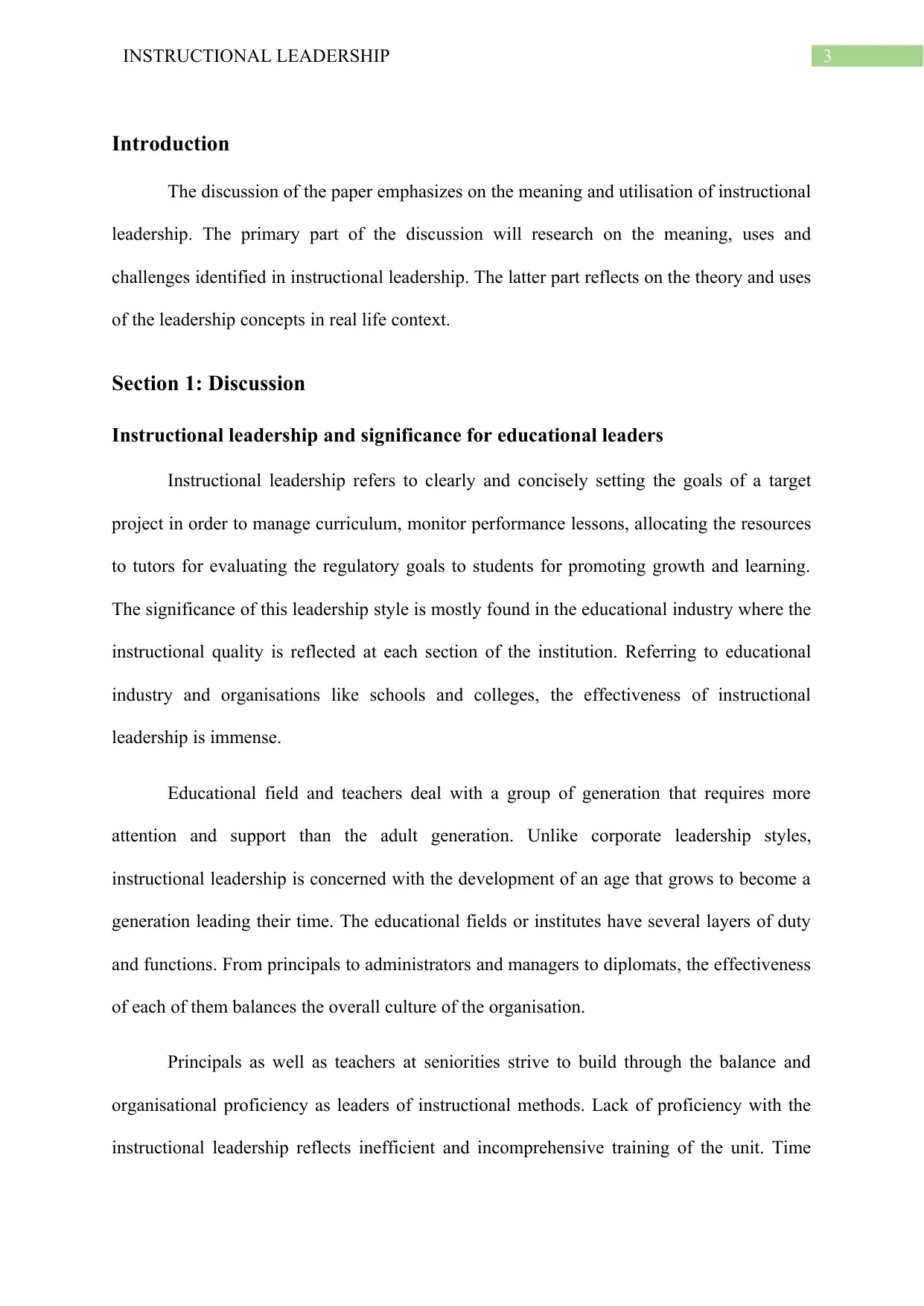
3INSTRUCTIONAL LEADERSHIP
Introduction
The discussion of the paper emphasizes on the meaning and utilisation of instructional
leadership. The primary part of the discussion will research on the meaning, uses and
challenges identified in instructional leadership. The latter part reflects on the theory and uses
of the leadership concepts in real life context.
Section 1: Discussion
Instructional leadership and significance for educational leaders
Instructional leadership refers to clearly and concisely setting the goals of a target
project in order to manage curriculum, monitor performance lessons, allocating the resources
to tutors for evaluating the regulatory goals to students for promoting growth and learning.
The significance of this leadership style is mostly found in the educational industry where the
instructional quality is reflected at each section of the institution. Referring to educational
industry and organisations like schools and colleges, the effectiveness of instructional
leadership is immense.
Educational field and teachers deal with a group of generation that requires more
attention and support than the adult generation. Unlike corporate leadership styles,
instructional leadership is concerned with the development of an age that grows to become a
generation leading their time. The educational fields or institutes have several layers of duty
and functions. From principals to administrators and managers to diplomats, the effectiveness
of each of them balances the overall culture of the organisation.
Principals as well as teachers at seniorities strive to build through the balance and
organisational proficiency as leaders of instructional methods. Lack of proficiency with the
instructional leadership reflects inefficient and incomprehensive training of the unit. Time
Introduction
The discussion of the paper emphasizes on the meaning and utilisation of instructional
leadership. The primary part of the discussion will research on the meaning, uses and
challenges identified in instructional leadership. The latter part reflects on the theory and uses
of the leadership concepts in real life context.
Section 1: Discussion
Instructional leadership and significance for educational leaders
Instructional leadership refers to clearly and concisely setting the goals of a target
project in order to manage curriculum, monitor performance lessons, allocating the resources
to tutors for evaluating the regulatory goals to students for promoting growth and learning.
The significance of this leadership style is mostly found in the educational industry where the
instructional quality is reflected at each section of the institution. Referring to educational
industry and organisations like schools and colleges, the effectiveness of instructional
leadership is immense.
Educational field and teachers deal with a group of generation that requires more
attention and support than the adult generation. Unlike corporate leadership styles,
instructional leadership is concerned with the development of an age that grows to become a
generation leading their time. The educational fields or institutes have several layers of duty
and functions. From principals to administrators and managers to diplomats, the effectiveness
of each of them balances the overall culture of the organisation.
Principals as well as teachers at seniorities strive to build through the balance and
organisational proficiency as leaders of instructional methods. Lack of proficiency with the
instructional leadership reflects inefficient and incomprehensive training of the unit. Time
Paraphrase This Document
Need a fresh take? Get an instant paraphrase of this document with our AI Paraphraser
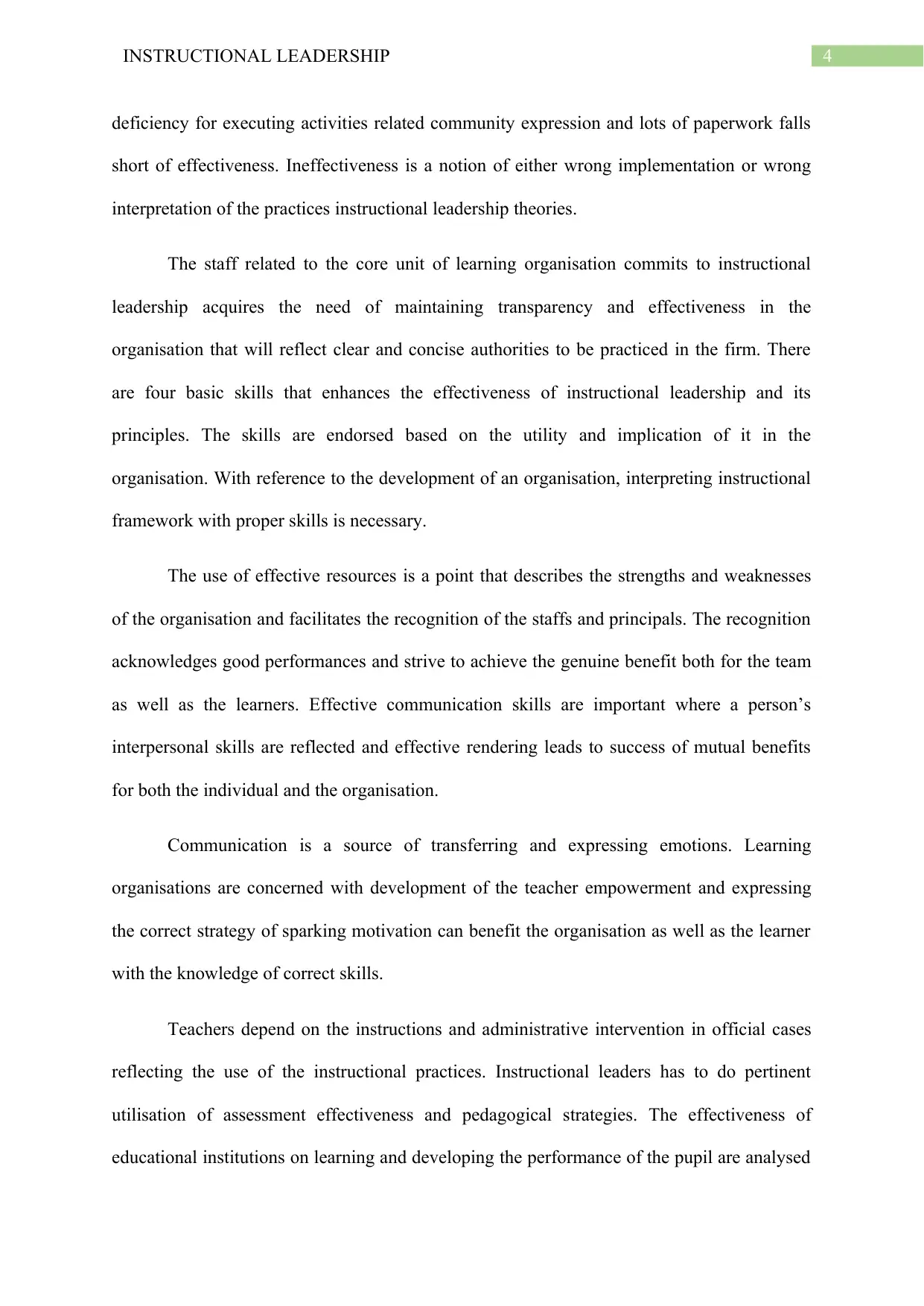
4INSTRUCTIONAL LEADERSHIP
deficiency for executing activities related community expression and lots of paperwork falls
short of effectiveness. Ineffectiveness is a notion of either wrong implementation or wrong
interpretation of the practices instructional leadership theories.
The staff related to the core unit of learning organisation commits to instructional
leadership acquires the need of maintaining transparency and effectiveness in the
organisation that will reflect clear and concise authorities to be practiced in the firm. There
are four basic skills that enhances the effectiveness of instructional leadership and its
principles. The skills are endorsed based on the utility and implication of it in the
organisation. With reference to the development of an organisation, interpreting instructional
framework with proper skills is necessary.
The use of effective resources is a point that describes the strengths and weaknesses
of the organisation and facilitates the recognition of the staffs and principals. The recognition
acknowledges good performances and strive to achieve the genuine benefit both for the team
as well as the learners. Effective communication skills are important where a person’s
interpersonal skills are reflected and effective rendering leads to success of mutual benefits
for both the individual and the organisation.
Communication is a source of transferring and expressing emotions. Learning
organisations are concerned with development of the teacher empowerment and expressing
the correct strategy of sparking motivation can benefit the organisation as well as the learner
with the knowledge of correct skills.
Teachers depend on the instructions and administrative intervention in official cases
reflecting the use of the instructional practices. Instructional leaders has to do pertinent
utilisation of assessment effectiveness and pedagogical strategies. The effectiveness of
educational institutions on learning and developing the performance of the pupil are analysed
deficiency for executing activities related community expression and lots of paperwork falls
short of effectiveness. Ineffectiveness is a notion of either wrong implementation or wrong
interpretation of the practices instructional leadership theories.
The staff related to the core unit of learning organisation commits to instructional
leadership acquires the need of maintaining transparency and effectiveness in the
organisation that will reflect clear and concise authorities to be practiced in the firm. There
are four basic skills that enhances the effectiveness of instructional leadership and its
principles. The skills are endorsed based on the utility and implication of it in the
organisation. With reference to the development of an organisation, interpreting instructional
framework with proper skills is necessary.
The use of effective resources is a point that describes the strengths and weaknesses
of the organisation and facilitates the recognition of the staffs and principals. The recognition
acknowledges good performances and strive to achieve the genuine benefit both for the team
as well as the learners. Effective communication skills are important where a person’s
interpersonal skills are reflected and effective rendering leads to success of mutual benefits
for both the individual and the organisation.
Communication is a source of transferring and expressing emotions. Learning
organisations are concerned with development of the teacher empowerment and expressing
the correct strategy of sparking motivation can benefit the organisation as well as the learner
with the knowledge of correct skills.
Teachers depend on the instructions and administrative intervention in official cases
reflecting the use of the instructional practices. Instructional leaders has to do pertinent
utilisation of assessment effectiveness and pedagogical strategies. The effectiveness of
educational institutions on learning and developing the performance of the pupil are analysed
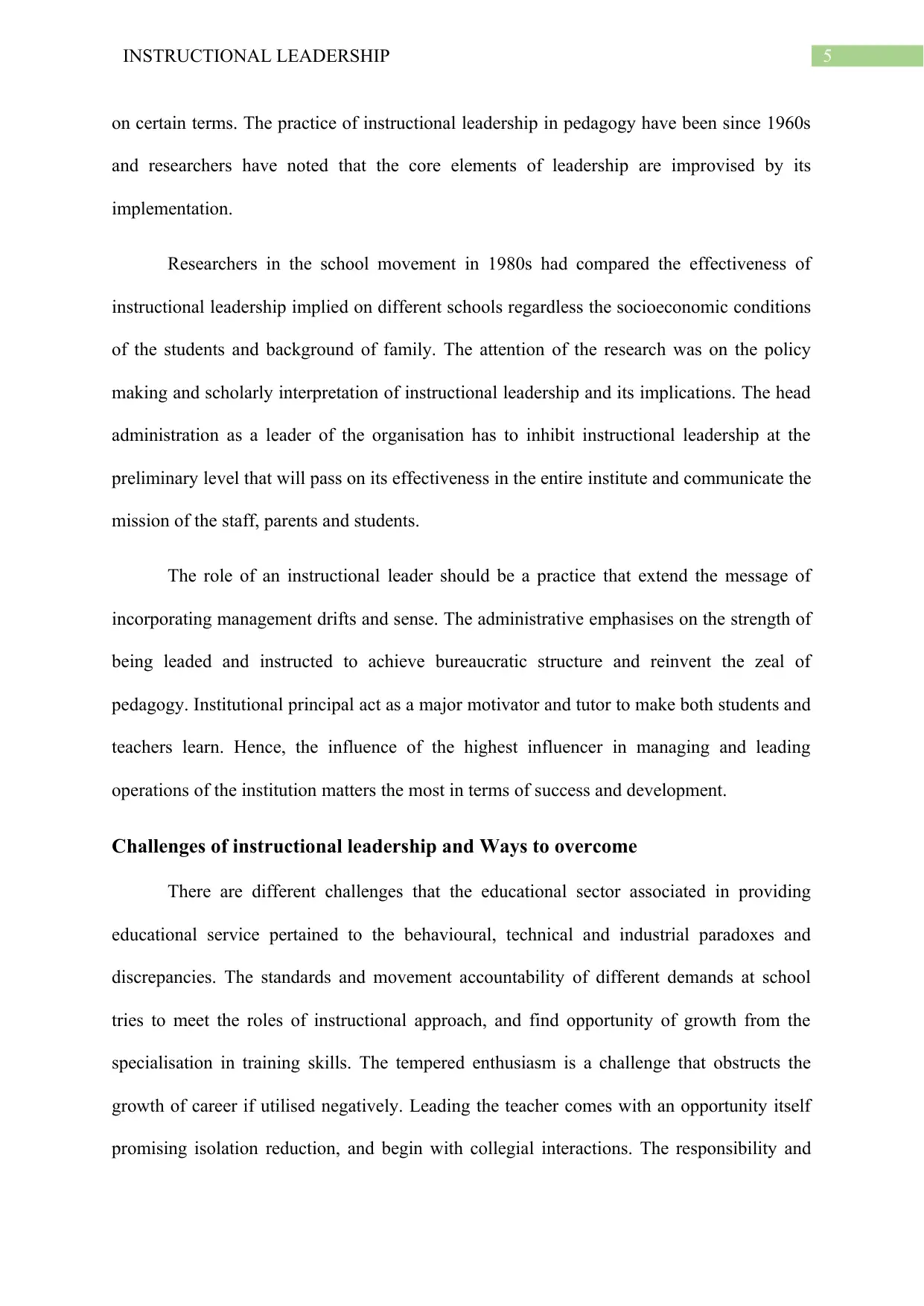
5INSTRUCTIONAL LEADERSHIP
on certain terms. The practice of instructional leadership in pedagogy have been since 1960s
and researchers have noted that the core elements of leadership are improvised by its
implementation.
Researchers in the school movement in 1980s had compared the effectiveness of
instructional leadership implied on different schools regardless the socioeconomic conditions
of the students and background of family. The attention of the research was on the policy
making and scholarly interpretation of instructional leadership and its implications. The head
administration as a leader of the organisation has to inhibit instructional leadership at the
preliminary level that will pass on its effectiveness in the entire institute and communicate the
mission of the staff, parents and students.
The role of an instructional leader should be a practice that extend the message of
incorporating management drifts and sense. The administrative emphasises on the strength of
being leaded and instructed to achieve bureaucratic structure and reinvent the zeal of
pedagogy. Institutional principal act as a major motivator and tutor to make both students and
teachers learn. Hence, the influence of the highest influencer in managing and leading
operations of the institution matters the most in terms of success and development.
Challenges of instructional leadership and Ways to overcome
There are different challenges that the educational sector associated in providing
educational service pertained to the behavioural, technical and industrial paradoxes and
discrepancies. The standards and movement accountability of different demands at school
tries to meet the roles of instructional approach, and find opportunity of growth from the
specialisation in training skills. The tempered enthusiasm is a challenge that obstructs the
growth of career if utilised negatively. Leading the teacher comes with an opportunity itself
promising isolation reduction, and begin with collegial interactions. The responsibility and
on certain terms. The practice of instructional leadership in pedagogy have been since 1960s
and researchers have noted that the core elements of leadership are improvised by its
implementation.
Researchers in the school movement in 1980s had compared the effectiveness of
instructional leadership implied on different schools regardless the socioeconomic conditions
of the students and background of family. The attention of the research was on the policy
making and scholarly interpretation of instructional leadership and its implications. The head
administration as a leader of the organisation has to inhibit instructional leadership at the
preliminary level that will pass on its effectiveness in the entire institute and communicate the
mission of the staff, parents and students.
The role of an instructional leader should be a practice that extend the message of
incorporating management drifts and sense. The administrative emphasises on the strength of
being leaded and instructed to achieve bureaucratic structure and reinvent the zeal of
pedagogy. Institutional principal act as a major motivator and tutor to make both students and
teachers learn. Hence, the influence of the highest influencer in managing and leading
operations of the institution matters the most in terms of success and development.
Challenges of instructional leadership and Ways to overcome
There are different challenges that the educational sector associated in providing
educational service pertained to the behavioural, technical and industrial paradoxes and
discrepancies. The standards and movement accountability of different demands at school
tries to meet the roles of instructional approach, and find opportunity of growth from the
specialisation in training skills. The tempered enthusiasm is a challenge that obstructs the
growth of career if utilised negatively. Leading the teacher comes with an opportunity itself
promising isolation reduction, and begin with collegial interactions. The responsibility and
⊘ This is a preview!⊘
Do you want full access?
Subscribe today to unlock all pages.

Trusted by 1+ million students worldwide
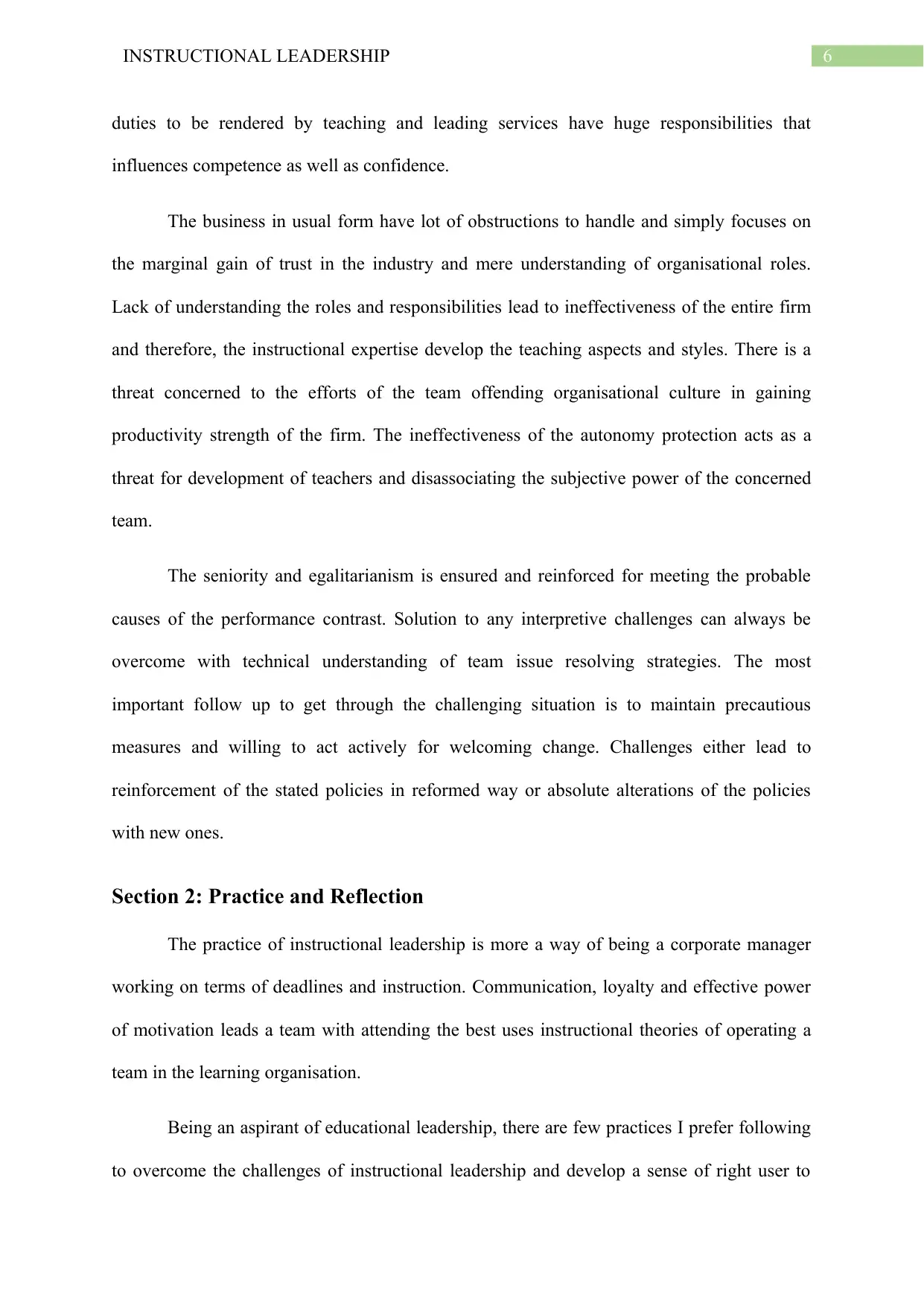
6INSTRUCTIONAL LEADERSHIP
duties to be rendered by teaching and leading services have huge responsibilities that
influences competence as well as confidence.
The business in usual form have lot of obstructions to handle and simply focuses on
the marginal gain of trust in the industry and mere understanding of organisational roles.
Lack of understanding the roles and responsibilities lead to ineffectiveness of the entire firm
and therefore, the instructional expertise develop the teaching aspects and styles. There is a
threat concerned to the efforts of the team offending organisational culture in gaining
productivity strength of the firm. The ineffectiveness of the autonomy protection acts as a
threat for development of teachers and disassociating the subjective power of the concerned
team.
The seniority and egalitarianism is ensured and reinforced for meeting the probable
causes of the performance contrast. Solution to any interpretive challenges can always be
overcome with technical understanding of team issue resolving strategies. The most
important follow up to get through the challenging situation is to maintain precautious
measures and willing to act actively for welcoming change. Challenges either lead to
reinforcement of the stated policies in reformed way or absolute alterations of the policies
with new ones.
Section 2: Practice and Reflection
The practice of instructional leadership is more a way of being a corporate manager
working on terms of deadlines and instruction. Communication, loyalty and effective power
of motivation leads a team with attending the best uses instructional theories of operating a
team in the learning organisation.
Being an aspirant of educational leadership, there are few practices I prefer following
to overcome the challenges of instructional leadership and develop a sense of right user to
duties to be rendered by teaching and leading services have huge responsibilities that
influences competence as well as confidence.
The business in usual form have lot of obstructions to handle and simply focuses on
the marginal gain of trust in the industry and mere understanding of organisational roles.
Lack of understanding the roles and responsibilities lead to ineffectiveness of the entire firm
and therefore, the instructional expertise develop the teaching aspects and styles. There is a
threat concerned to the efforts of the team offending organisational culture in gaining
productivity strength of the firm. The ineffectiveness of the autonomy protection acts as a
threat for development of teachers and disassociating the subjective power of the concerned
team.
The seniority and egalitarianism is ensured and reinforced for meeting the probable
causes of the performance contrast. Solution to any interpretive challenges can always be
overcome with technical understanding of team issue resolving strategies. The most
important follow up to get through the challenging situation is to maintain precautious
measures and willing to act actively for welcoming change. Challenges either lead to
reinforcement of the stated policies in reformed way or absolute alterations of the policies
with new ones.
Section 2: Practice and Reflection
The practice of instructional leadership is more a way of being a corporate manager
working on terms of deadlines and instruction. Communication, loyalty and effective power
of motivation leads a team with attending the best uses instructional theories of operating a
team in the learning organisation.
Being an aspirant of educational leadership, there are few practices I prefer following
to overcome the challenges of instructional leadership and develop a sense of right user to
Paraphrase This Document
Need a fresh take? Get an instant paraphrase of this document with our AI Paraphraser
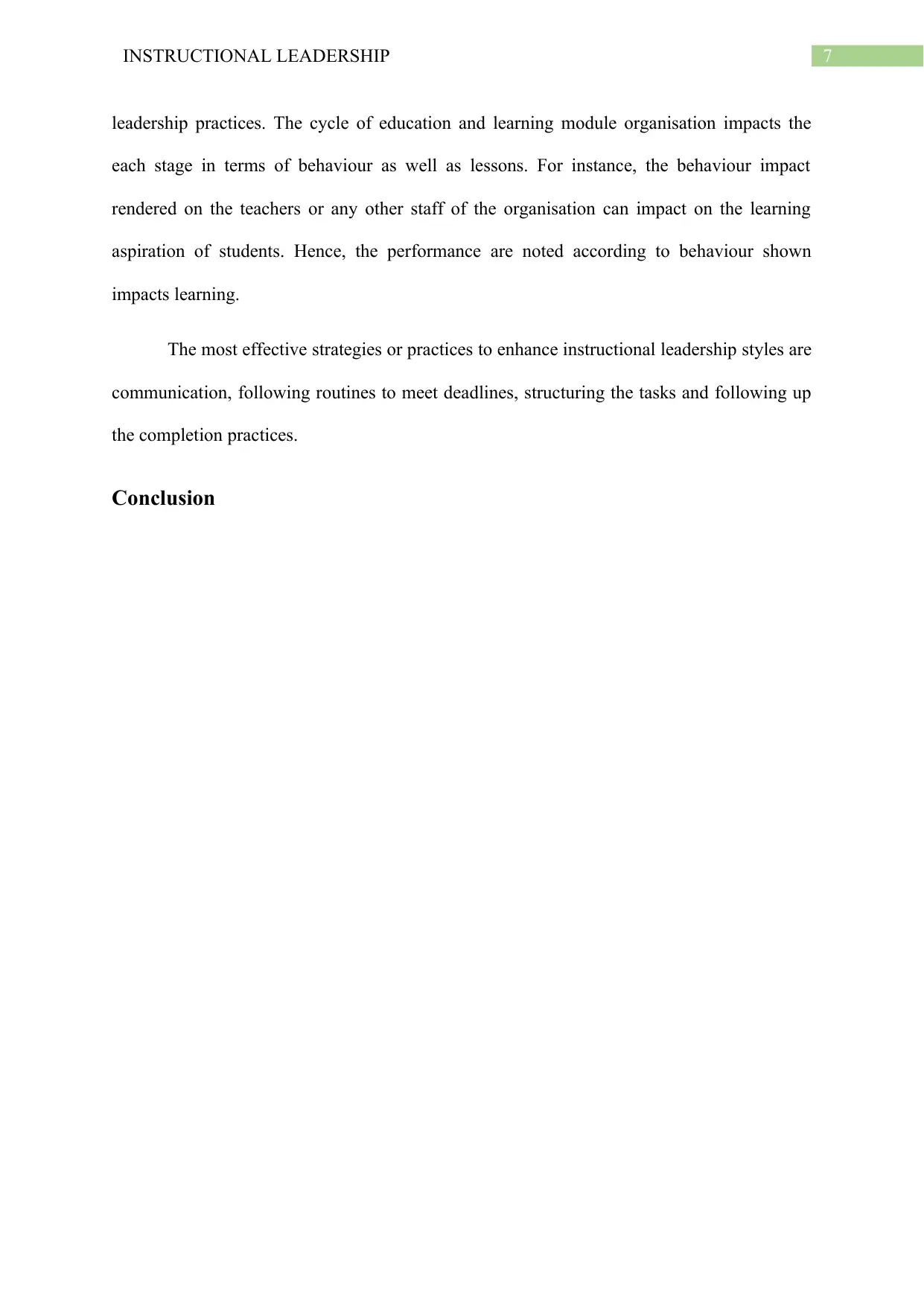
7INSTRUCTIONAL LEADERSHIP
leadership practices. The cycle of education and learning module organisation impacts the
each stage in terms of behaviour as well as lessons. For instance, the behaviour impact
rendered on the teachers or any other staff of the organisation can impact on the learning
aspiration of students. Hence, the performance are noted according to behaviour shown
impacts learning.
The most effective strategies or practices to enhance instructional leadership styles are
communication, following routines to meet deadlines, structuring the tasks and following up
the completion practices.
Conclusion
leadership practices. The cycle of education and learning module organisation impacts the
each stage in terms of behaviour as well as lessons. For instance, the behaviour impact
rendered on the teachers or any other staff of the organisation can impact on the learning
aspiration of students. Hence, the performance are noted according to behaviour shown
impacts learning.
The most effective strategies or practices to enhance instructional leadership styles are
communication, following routines to meet deadlines, structuring the tasks and following up
the completion practices.
Conclusion
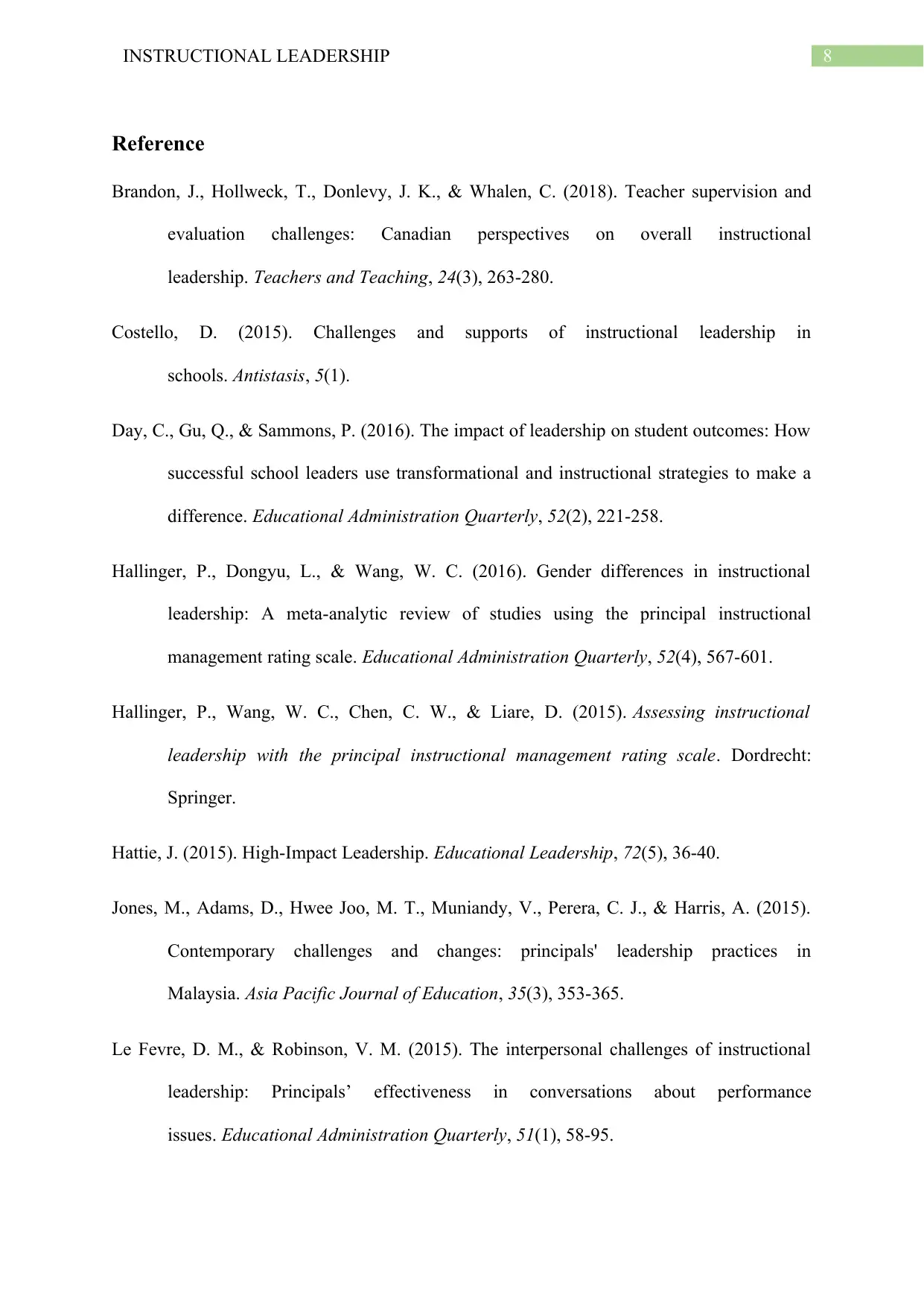
8INSTRUCTIONAL LEADERSHIP
Reference
Brandon, J., Hollweck, T., Donlevy, J. K., & Whalen, C. (2018). Teacher supervision and
evaluation challenges: Canadian perspectives on overall instructional
leadership. Teachers and Teaching, 24(3), 263-280.
Costello, D. (2015). Challenges and supports of instructional leadership in
schools. Antistasis, 5(1).
Day, C., Gu, Q., & Sammons, P. (2016). The impact of leadership on student outcomes: How
successful school leaders use transformational and instructional strategies to make a
difference. Educational Administration Quarterly, 52(2), 221-258.
Hallinger, P., Dongyu, L., & Wang, W. C. (2016). Gender differences in instructional
leadership: A meta-analytic review of studies using the principal instructional
management rating scale. Educational Administration Quarterly, 52(4), 567-601.
Hallinger, P., Wang, W. C., Chen, C. W., & Liare, D. (2015). Assessing instructional
leadership with the principal instructional management rating scale. Dordrecht:
Springer.
Hattie, J. (2015). High-Impact Leadership. Educational Leadership, 72(5), 36-40.
Jones, M., Adams, D., Hwee Joo, M. T., Muniandy, V., Perera, C. J., & Harris, A. (2015).
Contemporary challenges and changes: principals' leadership practices in
Malaysia. Asia Pacific Journal of Education, 35(3), 353-365.
Le Fevre, D. M., & Robinson, V. M. (2015). The interpersonal challenges of instructional
leadership: Principals’ effectiveness in conversations about performance
issues. Educational Administration Quarterly, 51(1), 58-95.
Reference
Brandon, J., Hollweck, T., Donlevy, J. K., & Whalen, C. (2018). Teacher supervision and
evaluation challenges: Canadian perspectives on overall instructional
leadership. Teachers and Teaching, 24(3), 263-280.
Costello, D. (2015). Challenges and supports of instructional leadership in
schools. Antistasis, 5(1).
Day, C., Gu, Q., & Sammons, P. (2016). The impact of leadership on student outcomes: How
successful school leaders use transformational and instructional strategies to make a
difference. Educational Administration Quarterly, 52(2), 221-258.
Hallinger, P., Dongyu, L., & Wang, W. C. (2016). Gender differences in instructional
leadership: A meta-analytic review of studies using the principal instructional
management rating scale. Educational Administration Quarterly, 52(4), 567-601.
Hallinger, P., Wang, W. C., Chen, C. W., & Liare, D. (2015). Assessing instructional
leadership with the principal instructional management rating scale. Dordrecht:
Springer.
Hattie, J. (2015). High-Impact Leadership. Educational Leadership, 72(5), 36-40.
Jones, M., Adams, D., Hwee Joo, M. T., Muniandy, V., Perera, C. J., & Harris, A. (2015).
Contemporary challenges and changes: principals' leadership practices in
Malaysia. Asia Pacific Journal of Education, 35(3), 353-365.
Le Fevre, D. M., & Robinson, V. M. (2015). The interpersonal challenges of instructional
leadership: Principals’ effectiveness in conversations about performance
issues. Educational Administration Quarterly, 51(1), 58-95.
⊘ This is a preview!⊘
Do you want full access?
Subscribe today to unlock all pages.

Trusted by 1+ million students worldwide
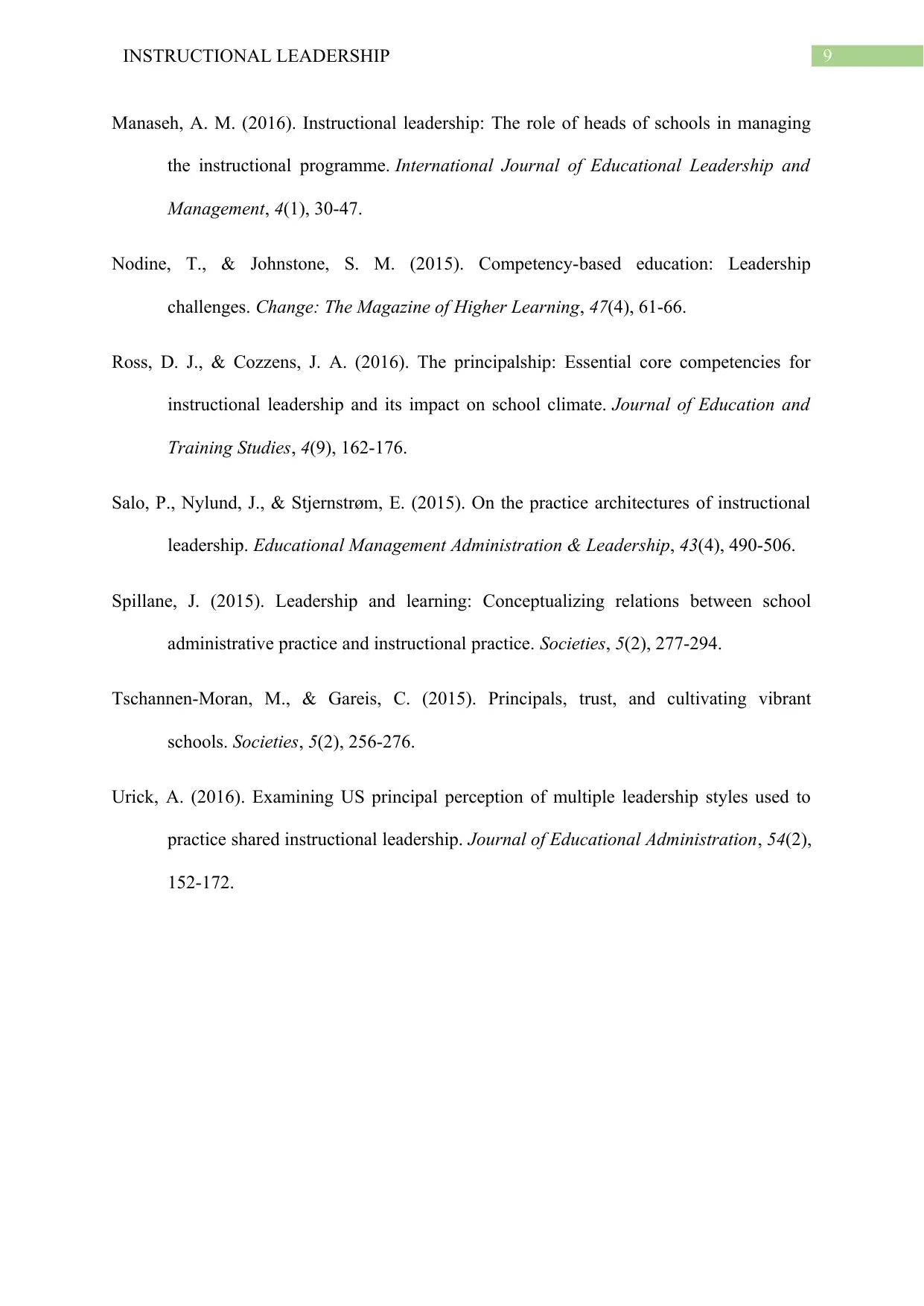
9INSTRUCTIONAL LEADERSHIP
Manaseh, A. M. (2016). Instructional leadership: The role of heads of schools in managing
the instructional programme. International Journal of Educational Leadership and
Management, 4(1), 30-47.
Nodine, T., & Johnstone, S. M. (2015). Competency-based education: Leadership
challenges. Change: The Magazine of Higher Learning, 47(4), 61-66.
Ross, D. J., & Cozzens, J. A. (2016). The principalship: Essential core competencies for
instructional leadership and its impact on school climate. Journal of Education and
Training Studies, 4(9), 162-176.
Salo, P., Nylund, J., & Stjernstrøm, E. (2015). On the practice architectures of instructional
leadership. Educational Management Administration & Leadership, 43(4), 490-506.
Spillane, J. (2015). Leadership and learning: Conceptualizing relations between school
administrative practice and instructional practice. Societies, 5(2), 277-294.
Tschannen-Moran, M., & Gareis, C. (2015). Principals, trust, and cultivating vibrant
schools. Societies, 5(2), 256-276.
Urick, A. (2016). Examining US principal perception of multiple leadership styles used to
practice shared instructional leadership. Journal of Educational Administration, 54(2),
152-172.
Manaseh, A. M. (2016). Instructional leadership: The role of heads of schools in managing
the instructional programme. International Journal of Educational Leadership and
Management, 4(1), 30-47.
Nodine, T., & Johnstone, S. M. (2015). Competency-based education: Leadership
challenges. Change: The Magazine of Higher Learning, 47(4), 61-66.
Ross, D. J., & Cozzens, J. A. (2016). The principalship: Essential core competencies for
instructional leadership and its impact on school climate. Journal of Education and
Training Studies, 4(9), 162-176.
Salo, P., Nylund, J., & Stjernstrøm, E. (2015). On the practice architectures of instructional
leadership. Educational Management Administration & Leadership, 43(4), 490-506.
Spillane, J. (2015). Leadership and learning: Conceptualizing relations between school
administrative practice and instructional practice. Societies, 5(2), 277-294.
Tschannen-Moran, M., & Gareis, C. (2015). Principals, trust, and cultivating vibrant
schools. Societies, 5(2), 256-276.
Urick, A. (2016). Examining US principal perception of multiple leadership styles used to
practice shared instructional leadership. Journal of Educational Administration, 54(2),
152-172.
1 out of 10
Related Documents
Your All-in-One AI-Powered Toolkit for Academic Success.
+13062052269
info@desklib.com
Available 24*7 on WhatsApp / Email
![[object Object]](/_next/static/media/star-bottom.7253800d.svg)
Unlock your academic potential
Copyright © 2020–2025 A2Z Services. All Rights Reserved. Developed and managed by ZUCOL.





